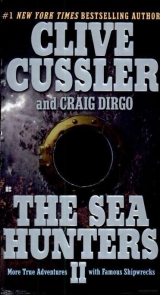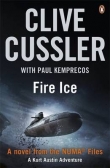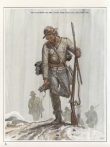
Текст книги "The Sea Hunters II: More True Adventures with Famous Shipwrecks"
Автор книги: Clive Cussler
Соавторы: Craig Dirgo
Жанры:
Прочая документальная литература
,сообщить о нарушении
Текущая страница: 8 (всего у книги 27 страниц)
PART FOUR
U.S.S. Mississippi

I
A Magnificent End 1863
On the heights of Port Hudson overlooking the Mississippi River, the Confederate batteries had managed to withstand the daylong bombardment by the Federal fleet, and now the night of March 14, 1863, was curiously quiet. Twenty miles above the state capital at Baton Rouge, Louisiana, the small riverboat landing was perched on a steep eighty-foot-high bluff at a point where the river made a sharp turn to the west. A narrow beach ran along the precipice, overgrown with willows and cottonwoods that provided cover for a two-gun battery.
Major General Franklin Gardner stared through the blackness of night at the stars reflected on the fast-flowing river. A native New Yorker, he had seen service in the Mexican War and fought Indians on the frontier. He had offered his services to the Confederacy because of his love for his wife, the daughter of Louisiana governor Alexandre Mouton, and his affection for his friends and neighbors that had come after many years of living in Baton Rouge.
Port Hudson had great strategic value. The Confederates had fortified the bluffs and thrown up earthworks on the land side because it gave them control of the Red River, as well as the Mississippi. As long as they held the Red River, supplies and troops could be brought into the Confederacy from Mexico through Texas. Gardner’s orders were to hold at all cost against the assault by Union General Nathaniel Banks and his troops. He would hold out for forty-eight days before surrendering during the first week of July.
In his early forties, Gardner was of medium height and slender, with sparse reddish hair. He peered into the darkness through a pair of binoculars for a few moments before lowering them. “I have a feeling Farragut will come before dawn.”
Lieutenant Wilfred Pratt of Company K, in command of the nearby gun, its muzzle pointed down to fire in the middle of the river, nodded in agreement. “I wouldn’t put it past them sneaky Yanks to make a try in the wee hours while it’s still dark.”
“It should be an interesting battle,” murmured Gardner, satisfied that his eighteen guns were well concealed in their emplacements and ready for action.
He and his seven-thousand-man force would soon be surrounded and besieged by a Union army, the same as their comrades at Vicksburg 110 miles upstream. Both positions were of vital importance to the Confederacy. As long as they controlled their positions above the Mississippi, it was too hazardous and costly in ships and men for the Union gunboats and transports to risk passage.
Gardner lifted his glasses again. “What time do you have?”
Lieutenant Pratt pulled a watch from a breast pocket by a gold chain, lit a match, and peered at the dial. “I have three minutes to eleven o’clock, sir.”
The words were barely uttered when two red rockets soared into the night sky, breaking the stillness of the air as they burst above the river. Captain Whitfield Youngblood of Gardner’s signal corps had ordered the rockets launched upon seeing the red light on the masthead of Farragut’s flagship Hartford,as the vessel passed his station. The Confederates were neither deceived nor surprised. Their eighteen big guns roared and flashed in a deafening crescendo of thunderclaps that never seemed to end.
Gardner and Pratt watched mesmerized as the Union fleet steadily moved up the river, their black hulls blending in with the dark river. The bedlam mushroomed as the combined 112 guns of the Union fleet, those of the ironclad Essex, and the mortar boats tied along the east bank blasted back in reply. The great thirteen-inch mortar shells with their burning fuses rose and fell like meteors within the Confederate fortifications. The sky became a giant fireworks display. The ground shuttered and vibrated as if rolled by an earthquake. The fiery spurts from the gun muzzles blazed and then blinked dark as their crews rammed new charges and shot down their smoking barrels.
Soon the smoke was so thick that gunners on both sides could only sight their guns on the enemy’s flashes. Confederate sharpshooters in rifle pits added to the maelstrom clatter as they fired at ships, hoping to bring down the crewmen.
* * *
“It won’t be easy swinging around the bend,” said Farragut’s pilot on board Hartford.George Alder stared down into the black water surging past the frigate’s hull. Then he glanced woefully at the gunboat Albatross that was lashed along the frigate’s port side. “Not with two ships tied side by side against a four-knot current.”
“The current is the least of my concern,” came the staunch reply. “Just keep us in the center of the river.”
Admiral David Glasgow Farragut, a tough Scot with a perennial smile, stood imperturbable. He was as unstirred as a rock assaulted by heavy surf – an image he’d displayed in the battle for New Orleans, as well as one for which he would become famous later, at the battle of Mobile Bay, when he’d ignore the Confederate minefield after losing one of his monitors and shout, “Damn the torpedoes! Full steam ahead!”
The opposite of General Gardner, Farragut came from the South. Though he’d been born in Tennessee, was raised in Louisiana, and lived in Virginia, he was devoted to the United States. After moving his family north, he’d joined the Union and was named flag officer in command of the West Gulf’s blockading squadron.
After his great victory at New Orleans, he was determined to run this fleet upriver to Vicksburg to try to aid General Grant in his siege of the city. Farragut turned and surveyed the ships lined up behind Hartford.The frigate Richmond,with the gunboat Geneseealongside, was directly astern. Then came the frigate Monongahela,tied to the gunboat Kineo.And finally the “old spinning wheel,” as the frigate Mississippiwas affectionately called because of her antiquated paddle wheels.
Bullets whizzed through the riggings as the rebel riflemen aimed high through the smoke, causing few casualties among Hartford’screw. The forty-two-gun sloop of war pushed through the smoke and was almost clear of the worst of the fire when the current caught her and swept her bow toward the Port Hudson batteries.
“The damned current!” shouted Alder. “I can’t hold her.”
A signal was quickly shouted across the bulwarks to the captain of Albatrossto reverse his engines while Hartford’sengineer poured on the coal full steam ahead. Slowly, the two ships swung on a ninety-degree angle upriver and steamed out of range of the deadly guns.
Farragut was wise enough to know that Hartfordand Albatross were lucky. The Confederates had not depressed their guns low enough to do damage to the Union ships, but they were not about to make the same mistake as the next ships in line came within range.
“I’m afraid the rest of the fleet is in for the worst of it,” he said apprehensively, as he saw a fire erupt from an old house on the west bank. The Confederates had obviously ignited it to light up the river and reveal the Union fleet.
Farragut was especially concerned about the last ship in line. Mississippiwas the oldest steamer in naval service. A hardened battle veteran, she had proved her worth in the run past the forts below New Orleans. By the time it was her turn to run the gauntlet, the Confederate gunners would have had time to zero in on her with deadly accuracy. She was about to find herself in the most exposed position of the entire fleet.
* * *
Throughout the nearly 250 years of its existence, the U.S. Navy has been blessed with any number of ships that contributed proud and illustrious service. Some benefit from household names like Bonhomme Richard, Monitor, Arizona,and Enterprise.But many others, with careers no less distinguished, are neglected and forgotten by all but a few naval historians. One such ship was the U.S.S. Mississippi.
The second to be built of the Navy’s oceangoing armed steamships, Mississippiwas commissioned on December 22, 1841, shortly before her sister ship, Missouri.Commodore Matthew C. Perry personally supervised her construction, and she was named after the mighty river that flowed through the heart of the country.
Mississippiwas a side-wheel steamer 229 feet in length with a beam of 40 feet and a depth of 19 feet. Her original gun battery consisted of two 10-inch and eight 8-inch guns. She had a respectable top speed of 8 knots, and she carried a crew of 280.
Unlike her virtual twin, Missouri,which sailed for only two years before accidentally catching on fire and exploding off of Gibraltar in 1843, Mississippienjoyed a long and glorious existence before she, too, burned and exploded.
She spent her first few years performing research and demonstrations vital to the evolution of steam-powered warships, before sailing to the West Indies, where she became the flagship of her construction overseer, Commodore Perry. In the right place at the right time during the war with Mexico, Mississippiengaged in actions against Tampico, Panuco, Alarado, and several other coastal ports, blockading incoming commerce. She was also heavily involved with the amphibious operations at Veracruz, where she landed vital military matériel for Winfield Scott’s army. She also supplied heavy guns, and the crews who fought them, all the way to Mexico City, where they bombarded fortifications and helped bring about the city’s surrender in only four days. Throughout much of the war, Mississippiconducted a series of raids on coastal towns before helping to capture the important town of Tobasco.
After the war, she cruised with the American fleet in the Mediterranean for two years before returning to America in preparation for Commodore Perry’s celebrated voyage to Japan. Mississippiwas his flagship on most of the expedition to open Japan to Western trade. In one of the most studied and admired naval and diplomatic operations in history, Perry negotiated a treaty with the emperor, and the nation that had been utterly opposed to outside influence opened its ports to international trade.
Mississippisailed for New York and later returned as Commodore Josiah Tatnall’s flagship. Commodore Tatnall “went south” at the beginning of the Civil War and was in command of Merrimack/Virginiaduring her lengthy battle with Monitor.
From 1857 to 1860, the now-aging ship supported and protected America’s booming trade in China and Japan. She was also with the British and French ships during the attack on Taku and landed her marines at Shanghai when the American consul requested Tatnall’s help in quelling the rioting in the city.
The veteran steamer sailed back to Boston and was laid up until it was reactivated at the beginning of the Civil War. Now under the command of Melancthon Smith, she was employed in blockading Pensacola, Florida. After capturing two Confederate blockade runners off Key West in late 1861, she joined Admiral David Farragut for the assault on New Orleans. When she passed over the bar at the South Pass, she became the largest ship ever to enter the Mississippi River.
As previously related, during the battle, as Farragut’s fleet ran the gauntlet between Forts St. Philip and Jackson, Mississippibattered the Confederate ironclad Manassasafter it made an unsuccessful attempt to ram and sink her. Surviving the hail of shot and shell from the forts, Mississippitriumphantly entered New Orleans with the rest of the fleet and aimed her guns on the buildings along the shore until the city capitulated.
Nearly a year after, Farragut ordered Smith to take Mississippiand join the ships that would attempt to pass the Confederate guns of Port Hudson to Vicksburg to help General Grant in his siege of the city. The battle of the bluffs would prove to be her final moment of glory.
* * *
Just as Richmond, the second ship in line, was turning the bend and within a hundred yards of safety, a shot ripped into her engine room and shattered her steam valves and pipes. Unable to maintain pressure and make headway with Geneseetied to her port side, her captain had no choice but to reverse course and retreat back down the river out of the range of Confederate guns.
Monongahelafared no better. A shell struck the rudderpost of Kineo, the gunboat making the run at the frigate’s side, and jammed it. Unable to steer against the current while maneuvering both ships, Monongahelaran aground. The sudden stop tore away the lines gripping the ships together. While under a devastating fire, Kineo struggled valiantly to get a hawser to the big frigate before pulling Monongahelafree of the bottom mud.
The two ships endeavored to resume their course upriver, but shots incapacitated the frigate’s engines, and both ships had to drift helplessly back down the river while sustaining heavy fire from the enemy gun batteries.
Alone and bringing up the rear, Mississippinow became the prime target. Concentrating their fire on the lone warship, the Confederates poured shell after shell into the old frigate. She soon became enveloped in a pall of swirling smoke.
Captain Melancthon Smith paced the bridge, calmly smoking a cigar, seemingly oblivious to the hail of shot and shell bursting on and around his ship. Mississippi’spaddle wheels were beating the water, propelling her past the bluffs alive with cannon fire. Her top speed of eight knots was cut to four from the equally fast speed of the current, and it seemed to the crew who were working their guns in furious haste that the passage was taking an eternity.
They were moving slowly, the pilot feeling his way through the heavy smoke. Believing that they were safely past the jutting point of the west bank and its shoals, the pilot called out, “Starboard helm! Full speed ahead!”
In the words of the Mississippi’sexecutive officer, George Dewey, “As it turned out, we were anything but past the point. We starboarded the helm right into it and struck just as we developed a powerful momentum. We were hard aground and listing.”
Dewey would later become the hero of Manila Bay, where his fleet of warships decimated the Spanish fleet, and he would utter words that have come down through naval history, along with John Paul Jones’s “I have not yet begun to fight,” Oliver Hazard Perry’s “We have met the enemy and they are ours,” and James Lawrence’s “Don’t give up the ship.” As the great Spanish-American War sea battle was about to commence, Dewey turned to the captain of his flagship, Olympia,and calmly said, “You may fire when ready, Gridley.”
Dewey was a handsome man with black straight hair, bushy sideburns, and a great mustache that he kept until his death in 1917.
With guns blasting, engines pounding with every ounce of steam the chief engineer could coax from them, and paddle wheels thrashing the water, old Mississippirefused to budge. The Confederates took happy advantage of the stationary target lit up by the nearby burning house, pouring in shells and a swarm of bullets from the rifle pits. As the ship struggled helplessly to back off the shoal, the number of dead and wounded climbed appallingly.
Dewey hunted for Captain Smith and found him lighting a cigar as coolly as if he were standing at a garden party. “Well, it doesn’t look as if we could get her off,” said Smith, almost indifferently.
“No, it does not,” Dewey replied.
At that moment, a fiery hot shot tore into the forward storeroom and set the inflammable supplies and matériel afire. A holocaust soon spread out of control as flames quickly reached the decks above. Looking around at the destruction and his mortally wounded command, Smith had to face the sad prospect of losing his ship.
“Can we save the crew?” he asked Dewey.
“Yes, sir.”
Shells had shattered the three boats on the side facing the enemy, but those on the port side were still seaworthy. Dewey directed a crew of able-bodied men to load the worst of the wounded into the first boat and directed the crew to row to one of the ships downstream.
Dewey supervised the loading of the lesser wounded and some that were unhurt. He was frustrated to see how slowly the boats returned. The oarsmen were decidedly unenthusiastic about making the trip back once they reached the temporary safety of the other ships. Unable to speed up the boats’ return to the burning ship, Dewey swung a line into a boat just as it was about to push off with a load of crewmen.
Though Dewey was reluctant to desert his ship, his decision turned out to be a wise one. He and the acting master, Joseph Chase, had to use their revolvers to make the men row back. If Dewey hadn’t slipped aboard, none of the boats would have been available to rescue the rest of Mississippi’sremaining crew.
Upon returning to the main deck, Dewey approached Smith and hastily explained his temporary absence. He motioned to the two empty lifeboats alongside, indicating that they would not be there save for his initiative and fortitude.
“We must make sure none is left aboard alive,” Smith said evenly.
What began as a compelling search soon turned into a grim nightmare. Dewey quickly selected five men to accompany him throughout the disabled warship. Bodies had to be closely examined in the dark and smoke to see if any of the men were still alive. They were very careful to make certain no spark of life remained, or the poor man might lie there, powerless to move, as the flames crept closer and closer.
They moved belowdecks, shouting that there was little time left to abandon the ship. Luckily, they found a young cabin boy who was still breathing despite being buried under a pile of dead bodies that had been cut down by bursting shells. Satisfied that only the dead remained on board, Dewey was then ordered by Smith to make absolutely certain that old Mississippiwould be totally destroyed before falling into Confederate hands.
Dewey ran to his stateroom, snatched off the mattress from his berth, and dragged it to the wardroom, where he sliced it open with a dress sword, piled chairs and tables on top of it, and then threw an old oil lantern into the debris, igniting a roaring fire almost immediately. Only then did he and the few men left on board join Captain Smith in the last lifeboat.
They pushed off from the hull aft of the paddle wheels and immediately were caught in the powerful current and swept downriver. As they looked back, a giant torrent of flame burst through the skylight of the wardroom that Dewey had set ablaze. The Confederate guns fired away at the lifeboat but fortunately failed to score a hit. At the sight of the flaming ship, the entire bluff above the river broke into a rebel yell. The victory was theirs.
Farragut’s fleet had come within an inch of total disaster.
Smith seated himself in the stern of the lifeboat, still puffing nonchalantly on a cigar while Dewey manned the tiller, and the men rowed through the splashing shells until they reached the safety of the battle-scarred Richmond,anchored downriver out of reach of the Confederate guns. During their flight, Smith took off his sword and revolvers and threw them into the river.
“Why did you do that?” Dewey asked him.
“I’m not surrendering them to any rebel,” he said haughtily. It was a hasty decision Smith would come to regret.
A humorous episode occurred when the men of Mississippiboarded Richmond.While Dewey was setting the fire in the wardroom on board the doomed ship, Ensign Dean Batcheller snatched up a dress uniform coat hanging in the cabin he shared with Ensign Francis Shepard. The rest of the crew, including Smith and Dewey, escaped with only the clothes on their backs.
Proudly, Batcheller held up the coat. “At least I’ll have something to wear for the ladies in New Orleans.”
His cabin mate Ensign Shepard leaned over and eyed the coat. Then he looked up and grinned. “Thanks very much, Batcheller, but that’s mycoat.”
And so it was.
Dewey was greeted by a close friend from his Naval Academy days at Annapolis, Winfield Scott Schley, who was destined to command the fleet that would destroy the Spanish fleet off Santiago, Cuba, at almost the same time Dewey was making his mark in the Philippines.
Back at the battered Mississippi,the river flowed in through the engine water-delivery pipes that had been cut by the engine-room crew before they abandoned ship. Because the hull was grounded on an angle with the bow slightly raised, the incoming water flowed toward the stern. The added weight lifted the bow, and she slid free off the shoal. The current turned her around so that now she was moving with her bow pointed downstream. The port guns that had been loaded but not fired now faced the Confederates. As the flames reached their primers, they began firing a ragged broadside in a final act of defiance. Dewey solemnly described the sight as “a ship manned by dead men still firing at the enemy.”
Engulfed by a sheet of fire that raged through the pummeled ship, Mississippiwas carried downriver by a four-knot current. The shriek of steam escaping from the ship’s safety valve cut through the pandemonium of gunfire. Flames burst from her rigging and erupted into the night sky, casting a flickering orange blaze of light that illuminated both shorelines as bright as day. Looking like a floating, flaming pyramid, Mississippiwas a funeral pyre for the dead aboard. It was a sight never forgotten by both the Federals and rebels who watched her fiery passage in the night. Her death would later be described as a grand spectacle.
Several reports from both sides in the battle put the frigate sliding off the shoals at 3 A.M. and drifting down around Profit Island, her flaming hull reflecting in the sky until 5:30, when the fire reached the twenty tons of gunpowder in her magazine and she blew up in a tremendous explosion. The ensuing concussion shook the country for miles around and rocked the Union ships from stem to stern. Such was the end of the brave old paddle steamer.
It was somehow fitting that the river she was named for became her burial shroud.
Perhaps Dewey himself paid Mississippiher greatest tribute when he stood on the deck of Richmond,stony-faced and deeply saddened as he watched her die. He said, “She goes out magnificently.”








